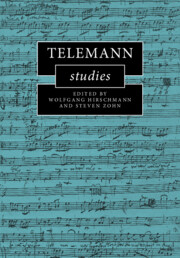Book contents
- Telemann Studies
- Cambridge Composer Studies
- Telemann Studies
- Copyright page
- Contents
- Figures
- Music Examples
- Tables
- Appendices
- Contributors
- Preface
- Abbreviations
- Part I Enlightenment Perspectives
- Part II Urban and Courtly Contexts
- Part III Nature (and) Theology in the Late Vocal Works
- 7 Telemann’s Donner-Ode and Lutheran Nature Theology
- 8 Body, Nature, and Emotion in Telemann’s Christmas Cantatas
- 9 Beyond Simplicity
- Part IV Bach Family Connections
- Part V Cantata Cycles in Frankfurt, Hamburg, and Beyond
- Index of Telemann’s Works
- General Index
7 - Telemann’s Donner-Ode and Lutheran Nature Theology
from Part III - Nature (and) Theology in the Late Vocal Works
Published online by Cambridge University Press: 14 July 2022
- Telemann Studies
- Cambridge Composer Studies
- Telemann Studies
- Copyright page
- Contents
- Figures
- Music Examples
- Tables
- Appendices
- Contributors
- Preface
- Abbreviations
- Part I Enlightenment Perspectives
- Part II Urban and Courtly Contexts
- Part III Nature (and) Theology in the Late Vocal Works
- 7 Telemann’s Donner-Ode and Lutheran Nature Theology
- 8 Body, Nature, and Emotion in Telemann’s Christmas Cantatas
- 9 Beyond Simplicity
- Part IV Bach Family Connections
- Part V Cantata Cycles in Frankfurt, Hamburg, and Beyond
- Index of Telemann’s Works
- General Index
Summary
Telemann’s 1756 vocal composition Der grosse Name Gottes, commonly called Donner-Ode, is based on the poetic paraphrase of Psalms 8 and 29 by J. A. Cramer. Both the poetry and Telemann’s music convey the sense of the sublime that was a prominent theme in late eighteenth-century aesthetics. Whether or not the work was a response to the 1755 Lisbon earthquake, its theology is in accord with an orthodox Lutheran belief in God’s providence and omnipotence. While it was written late in Telemann’s life, the ideas are continuous with the early influence of physico-theologians, who regarded the natural world as part of a divine plan in which even destructive events such as storms and earthquakes had a benevolent purpose. Hamburg was a strong center for physico-theology in the early eighteenth century, and Telemann was personally connected with several adherents of this direction of thought, among whom the best known is Barthold Heinrich Brockes.
Keywords
- Type
- Chapter
- Information
- Telemann Studies , pp. 165 - 178Publisher: Cambridge University PressPrint publication year: 2022

